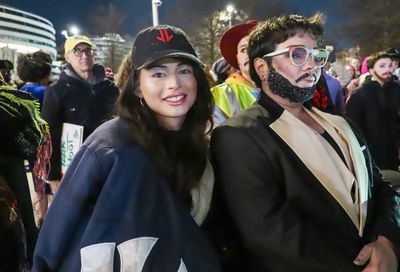End Game
Both sides in Wone trial present arguments to trial judge; verdict expected early next week
The conspiracy trial of three gay men implicated in the 2006 murder of attorney Robert Wone rested amid dramatic flourishes this week, with a verdict anticipated to come sooner rather than later.
The men — Victor Zaborsky, Dylan Ward and Joseph Price — stand accused of conspiracy, obstruction of justice and, in Price’s case, evidence tampering in Wone’s slaying on Aug. 2, 2006. None have been charged with murder, although much of the trial centered on the circumstances of Wone’s still-unsolved stabbing at the defendants’ house at 1509 Swann St. NW.
Both the prosecution and defense agreed that Wone’s mysterious murder — and the many questions that have lingered since — went largely unanswered in this trial. Proof, the government alleges, of a tight-knit polyamorous family ”circling the wagons” and protecting one of its own.
”They lied, they misdirected, they orchestrated and tampered,” said Assistant U.S. Attorney Glenn Kirschner in his closing argument. ”They’ve successfully prevented this murder from being solved…and they should all be held accountable.”
The prosecution aggressively implicated the three in Wone’s murder, saying repeatedly ”they know who did it, and they’re covering it up.” The hammering brought tears from members of the Ward family in the courtroom, and pained expressions among the three defendants – notably Zaborsky.
Screams To Grunts
Kirschner worked hard to portray inconsistencies in the crime scene and in the defendant’s statements as evidence of conspiracy and obstruction. Noting Zaborsky’s change in characterizing noises heard that night ”…from screams to grunts…” he tried to paint a picture of collusion among Price, Zaborsky and Ward, all to throw the MPD off track.
Despite his assertions, Judge Leibovitz frequently interrupted Kirschner’s closing statements, turning a planned hour of comments into two hours of legal give and take. ”When did it (the conspiracy) begin? What are the facts?” Leibovitz queried. ”I’m interested in what inferences should be drawn, rather than just reminding me of evidence,” she said, asking for the strongest and clearest narrative from the prosecution in a case notable for its many unknowns.
The three defendants collectively waived their right to a trial by jury, leaving Leibovitz in the position of being both finder of fact, and finder of law in an unusually complicated case. Earlier in the year the government had asserted far broader accusations against the defendants – raising questions of large-scale crime scene tampering, incapacitation, sexual torture and more. Most of the more salacious elements of the case never made it into evidence in the trial, and although Leibovitz in the role of judge is aware of all of them, she is not allowed to take them into consideration in the jury’s role as fact finder.
A Patchwork of Suspicious Circumstances
The three men are represented by a team of attorneys — among them some of Washington’s most accomplished defenders, such as Thomas Connolly, Bernie Grimm, David Schertler and openly gay attorney Robert Spagnoletti. It’s a legal team that many have noted must come at high cost.
Ward counsel David Schertler characterized the government’s case as ”an assembled patchwork of suspicious circumstances,” and in an hour-long closing argument proceeded to pick apart each of the government’s assertions as leaps of faith.
”There’s a void in the evidence they can’t fill,” he asserted. Not so surprising, given the government’s own admission of how much could not be said of that night – proof, they would argue, of the ”success” of the conspiracy.
Schertler marched through the prosecution’s arguments item by item, calling them ”little suspicious circumstances.” Robert’s neatness, the towels on the chair, the sheets turned partway down, the ”stares and glares.” Hair and fibers, pork loins, bruise marks, the cutlery set: for each Schertler lanced the government’s interpretation, offering a reasonable alternate interpretation, each with the incantation of ”it makes no sense…you can’t infer guilt.”
In her close, Assistant U.S. Attorney Rachel Carlson Lieber began what would be the final words in the Wone trial argument.
”We don’t know what happened to Robert Wone that night of Aug. 2, 2006. They did, and they lied,” she began. ”Kathy Wone doesn’t know” what happened to her husband that night, ”they do and they lied. Robert Wone’s parents don’t know what happened to their son that night, they do and they lied.”
The government’s case closing came down to one simple equation: A lie equals obstruction of justice.
This was Lieber’s answer to Schertler, Connolly and Grimm: that this case wasn’t a ”panoply of little suspicious circumstances” as Schertler characterized it, isolated and separate. It was instead the totality of all of it taken together. If David Schertler tried to tear apart the ”patchwork of suspicious circumstances,” Carlson Lieber worked to stitch it back together into a whole quilt.
What Are The Facts?
Throughout, Judge Leibovitz quizzed both sides in an effort, as she said, to help her focus her thinking. Much of her prodding came down to basic questions of facts asserted, and necessary interpretations.
”How much knowledge would you have to have to be a liar?” Leibovitz queried. ”At what point does willful ignorance become obstruction?” Why did none of the defendants at least try to offer another explanation, other than the intruder, instead of ”throwing up their hands passively,” as she characterized it. When do ”the facts indicate the conspiracy began – at the earliest and the latest? And why does the time line matter, given the limited accusation of tampering?”
It’s been nearly four years since Robert Wone was found slain on Swann Street. The trial has taken nearly 18 months from its first indictment issued late in 2008. Thousands of items of evidence, scores of witnesses, uncounted legal fees and five weeks of actual trial have led to this moment: Judge Leibovitz ended the trial Friday and announced her intention to have a verdict Tuesday, June 29, at 11 a.m., barring any last issues.
And at the end of it all, there will still be no answer to the questions of who murdered Robert Wone.
Doug Johnson is a co-editor of the website whomurderedrobertwone.com.
Support Metro Weekly’s Journalism
These are challenging times for news organizations. And yet it’s crucial we stay active and provide vital resources and information to both our local readers and the world. So won’t you please take a moment and consider supporting Metro Weekly with a membership? For as little as $5 a month, you can help ensure Metro Weekly magazine and MetroWeekly.com remain free, viable resources as we provide the best, most diverse, culturally-resonant LGBTQ coverage in both the D.C. region and around the world. Memberships come with exclusive perks and discounts, your own personal digital delivery of each week’s magazine (and an archive), access to our Member's Lounge when it launches this fall, and exclusive members-only items like Metro Weekly Membership Mugs and Tote Bags! Check out all our membership levels here and please join us today!





















